The Digital Age has empowered the customer like never before, especially, within the eCommerce realm, primarily due to the alluring promise of better deals, optimized convenience, faster deliveries, broader choices, desired qualities, and customized services. This has also led to an emboldened customer who is more prone to throwing away the cloak of silence to express his/her opinions online due to the realized influence of being able to tinker with an organization’s business reputation by a few keystrokes on a highly frequented social media/consumer forum website. Consequently, progressive organizations are taking extensive measures in knowing their customers deeply through the use of relevant methods/metrics as a way of gaining insights into providing more delightful experiences. However, it remains a daunting challenge to meet/exceed customer expectations on a consistent basis due to their dynamic nature. This is further exacerbated by the nagging fear of disruptive influences that can not only impact products/services, but also, radically change the relevant ecosystem, e.g., Amazon disrupted/transformed the ecosystem of conventional retailing through online dominance and forced key competitors like Walmart to rethink their strategies for staying relevant and competitive in the Digital Age.
A simple way to visualize the relationship between customer expectations and customer experiences is as follows:
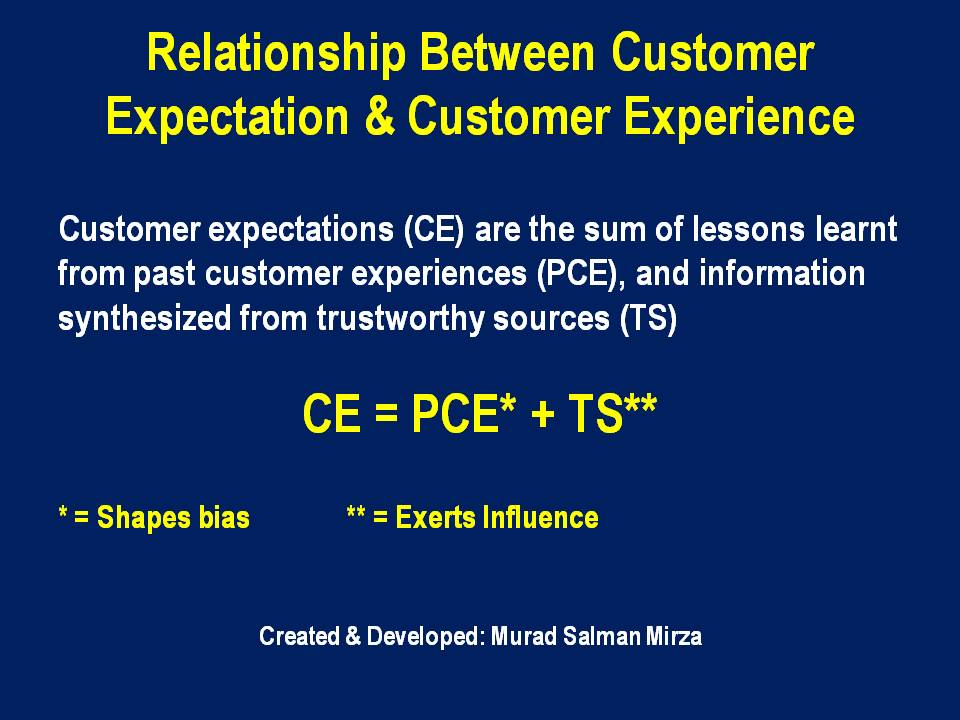
The aforementioned depiction is a qualitative characterization of the relationship between customer expectation and customer experience. If the Past Customer Experiences (PCE) with respect to a certain eCommerce provider are equal to zero, i.e., a first-time interaction, then the Customer Expectations (CE) are totally reliant on Trusted Sources (TS), e.g., family, friends, acquaintances, prominent multimedia sources, marketing material from the eCommerce provider, customer’s own self-confidence on random research or experiences with other eCommerce providers, etc. On the other hand, if both PCE and TS are equal to zero, then the customer is in the exceedingly rare position of proceeding with no expectations and is exposing himself/herself to an uncalculated risk. The interaction between an eCommerce provider and the customer can be illustrated through ‘The Eyeglasses Model’ as follows:
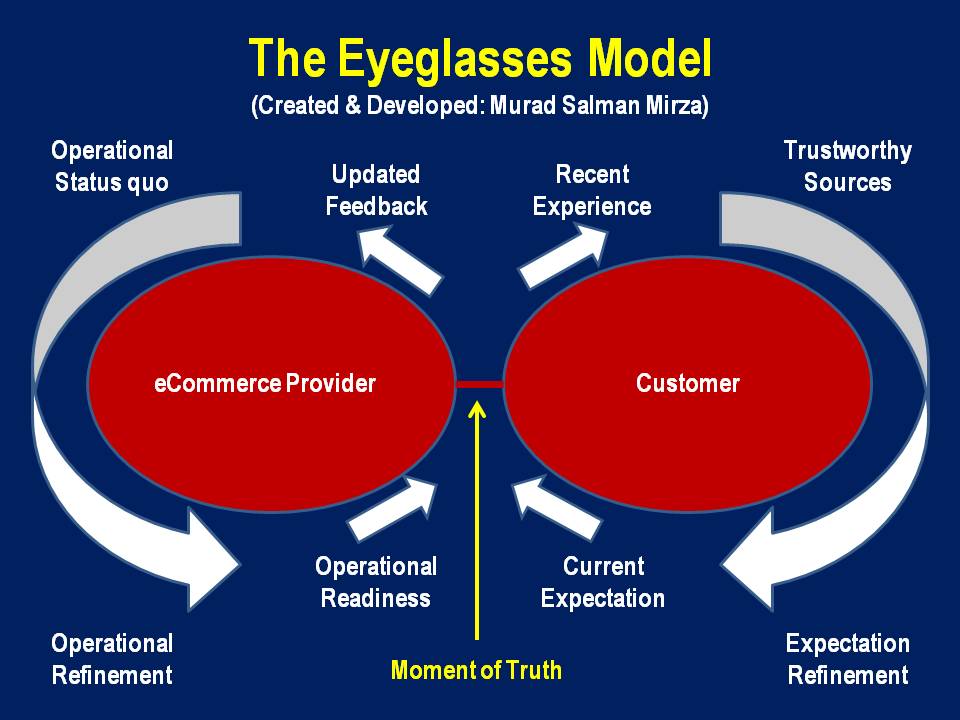
The ‘Moment of Truth’ depicts the stage where customer expectations are gauged against actual customer experiences that takes place between an eCommerce provider and the customer through an online channel, e.g., website, app, personal digital assistant (PDA), Virtual Reality (VR), Augmented Reality (AR), hologram, etc. The left side shows the readiness and refinement of the operational cycle for the eCommerce provider, while, the right side shows the initial and subsequent refinement of the expectation cycle of the customer, before and after the interaction between the two parties.
Let’s review the following ways in which the gap between customer expectation and customer experiences can be bridged:
Know Your Customers Comprehensively
This refers to having a profound understanding of the customer needs and expectations. It goes beyond the comprehension of rudimentary demographics and incorporates sensitivities, tendencies and inclinations that have to be ‘dug out’, especially, as organizations seek a global footprint. This includes:
> Demographics (age, gender, location, etc.)
> Preferences (brands, next best alternatives, fashion conscious, deal seekers, etc.)
> Likes & Dislikes (products, process, placement, positioning, pricing, etc.)
> Sensitivities (social causes, environmental concerns, behavioral triggers, religion, ethnicity, gender, privacy, security, etc.)
> Habits & Frequencies (how often they shop, what time they shop, seasonal surge, buying small or bulk, etc.)
> Personalities (prone to criticize, mostly silent, easy to delight, positive mindset, prolific reviewers, etc.)
The aforementioned aspects need to be consistently monitored at periodic intervals since bridging the gap between customer expectation and customer experience is a journey and not a destination as customers continue to evolve in their needs and expectations.
Awaken the ‘Silent’ Customers
This refers to establishing an active channel of communication with the customers who are not prone to providing feedback. They are usually in the majority and have to be coaxed into sharing opinions/perspective about their experiences. A visual depiction of the respective phenomenon can be seen in the following graphic:
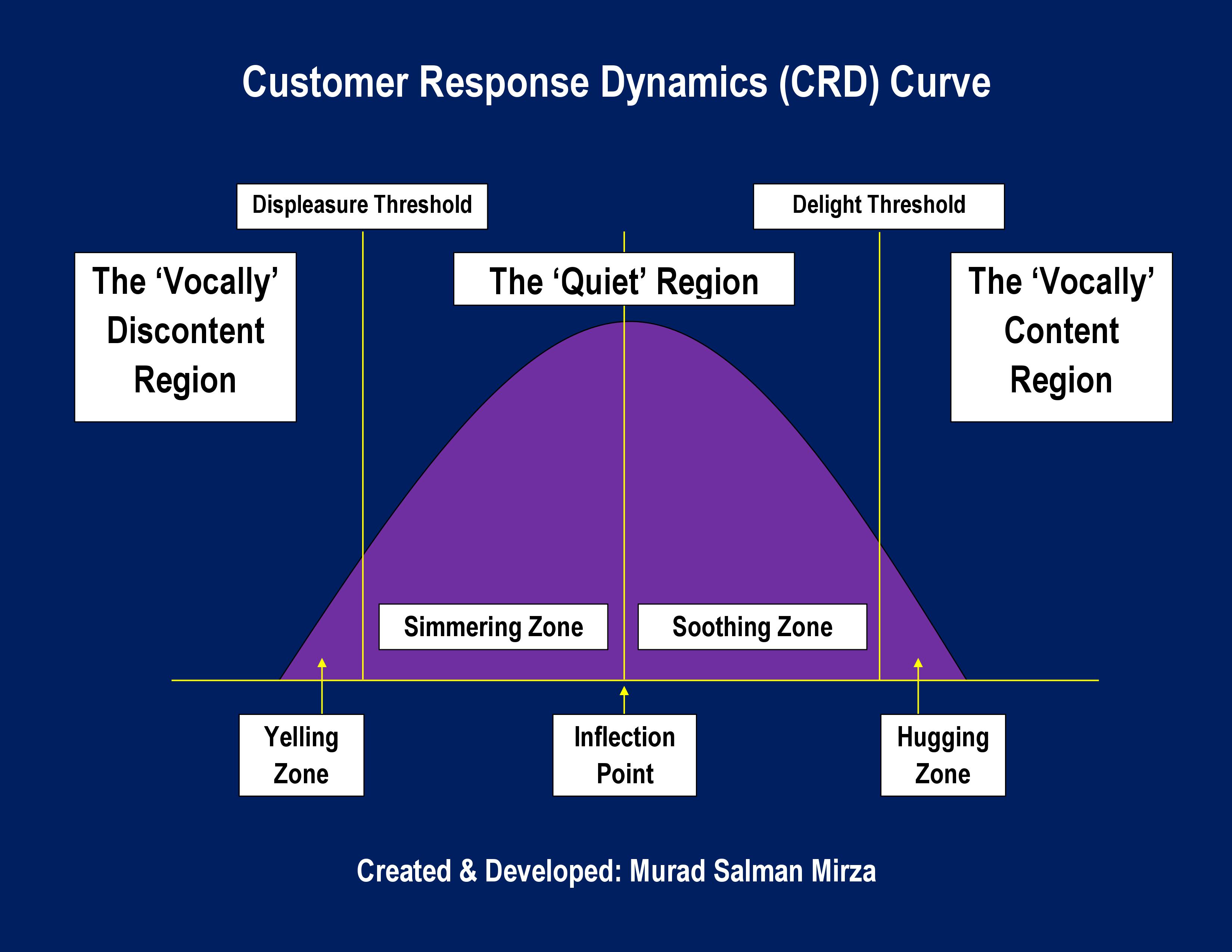
Some of the initiatives that can be undertaken to increase the ‘Voice of the Customer (VOC)’ are: Online Feedback Form, Voice Mail Facility, Short Personal Interview, Dedicated Customer Online Forum, Prime Customer WhatsApp Group, General Customer Facebook Group, Research Focus Group, Incentive-Based Activities (Fun Runs, Barbeques, Random Draws, Sample Testing, Recycling Drives, etc.)
A prudent approach to achieving success in the respective context is to always remember the golden rule that ‘a silent customer is not necessarily a satisfied/happy customer’.
Focus on the Metrics that Matter to Your Customers
This refers to increasing emphasis on the metrics that hold significance for the customer, rather than, disproportionately concentrating on those parameters that are more important for the eCommerce provider. For example, a customer attributes lesser significance to how much revenue is being earned from the sale of a certain product, how much does it cost to deliver that product to the customer and the mode of transportation utilized. What matters more to the customer is that they have a wide range to select the product, easy payment options, on-time delivery, without damage, and the behavior of the delivery person. This can be visualized in the following case of a typical service evaluation within the eRetailing realm:
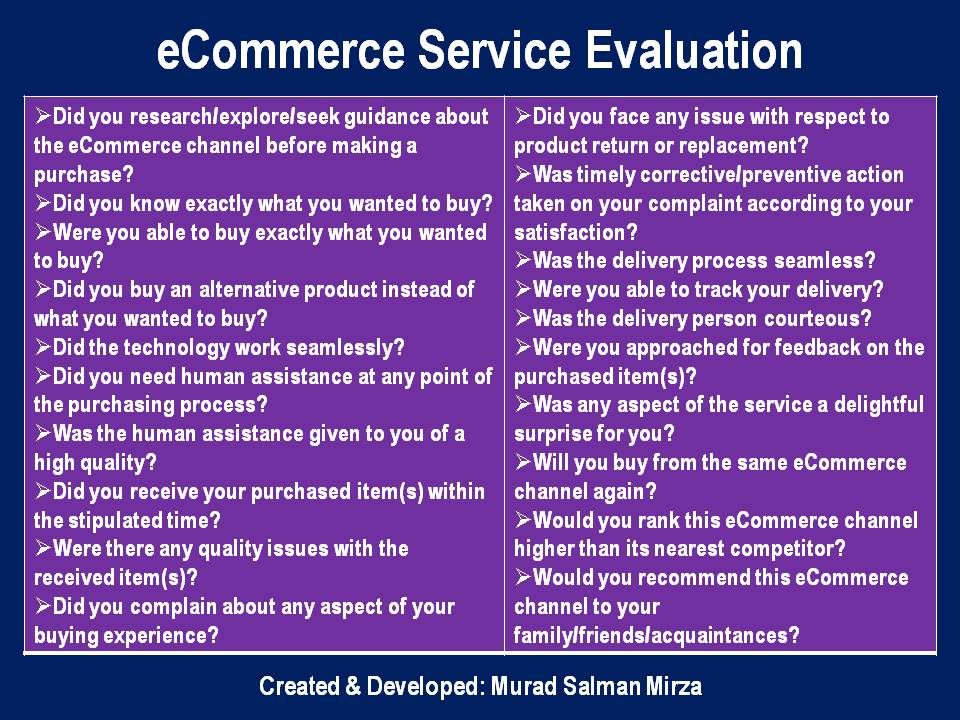
Extracting information on relevant metrics from a customer perspective by utilizing appropriate means in awakening the ‘silent’ customer, enables organizations to increase the ‘delight factor’ in future transactions
Don’t Overpromise and Under-Deliver
This refers to a balanced approach in terms of upholding the ‘actual’ and ‘psychological’ pledge given to the customer by the eCommerce provider by leveraging the promise of technology and taking ownership of the whole interactive journey, including the ‘last mile’. It focuses on cultivating and managing realistic expectations, which encompass:
> Broad Product Range (Preferred Brands, Next Best Alternatives (NBAs), etc.)
> Conducive Types of Services (Multichannel, Multimodal, Omnichannel, etc.)
> Multimedia Communication Platforms
> Synergistic Channel Partners
> Astute Management of Regulatory Conditions
For example, an organization promising the delivery of products by drones as a competitive advantage has to be mindful of not only covering the delivery aspect within a stipulated time, but also, effectively catering to product return, product replacement, and product recall within a industry-leading standard. This includes answering questions like, what area can the drones effectively cover, how many drones can fly at any given time to meet the promised standards, what is a typical charging time for a drone to be put back into service, are there any weather conditions that affect the drone services, is there any alternative service available in case drone services are disrupted, are there restricted zones where drone service cannot be done within the operational zone, what is the most effective way to retrieve a drone if it is damaged/lost/erratic during flight, what are the maintenance schedules for drones, what are the relevant regulatory conditions for drone operations, is there adequate remedy available in case of any litigation due to drone operations, etc.
A key pitfall to avoid in the respective context is to leverage breakthrough technology on poor/untested/immature service models. It often ends up significantly damaging the organizational brand due to the precipitous fall in the hype associated with the respective technology as it fails to deliver on its promise. Consequently, two simple rules should be followed in the respective context, i.e.:
> Never promise what can’t be feasibly delivered
> Once promised; deliver at all costs
The aforementioned principles are especially significant for eCommerce providers that are operating in highly competitive markets since unpleasant experiences are like bad memories that tend to linger even after compensatory actions are undertaken and prone to ‘healing times’ that differ from customer to customer.
Customize ‘Delight’ Factors for Your Customers
This refers to the astute utilization of customer knowledge that pays heed to the fact that it is more important to know how your customers are making decisions, rather than, what decisions they have made. This provides an insight into the mindset of customers that can be leveraged to bridge the gap between customer expectation and custom experience through seamless service peppered with delight factors. This can be illustrated by the following example of a customer trying to buy a pair of jeans from an eRetailer:
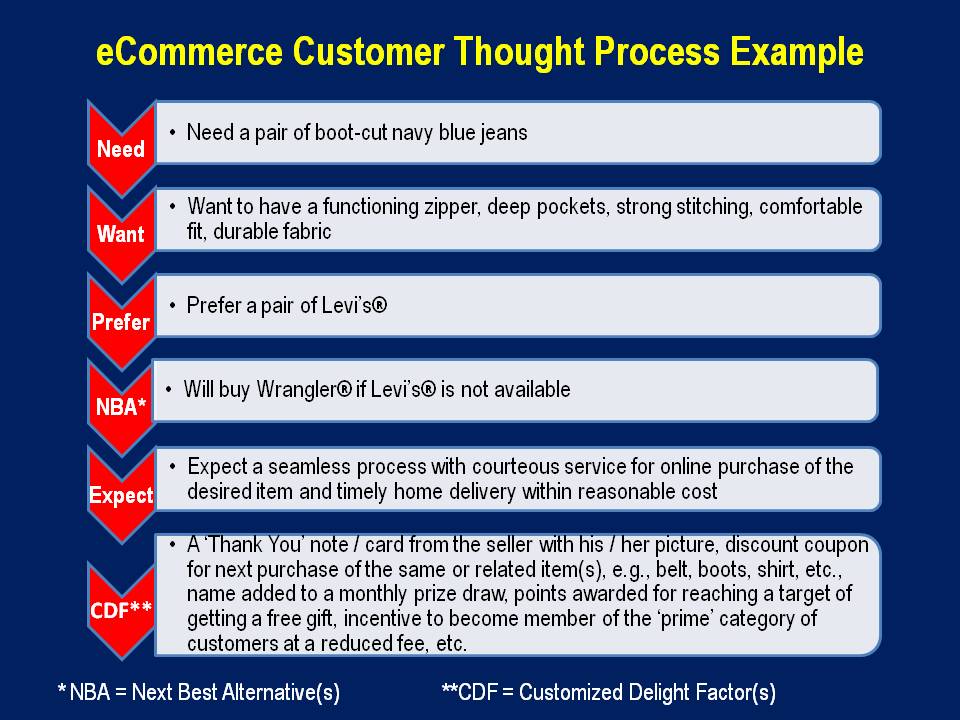
Gaining such insights and realizing the ‘true’ extent of success in such initiatives can be ascertained from the various sources that have already been highlighted in ‘Awakening the ‘Silent’ Customer’ segment.
Take Good Care of Your Employees
This refers to realizing and framing the strategic focus of an organization with the ‘human factor’ being the key driving force behind superior eCommerce success, rather than, the overleveraging of groundbreaking technology. Such a strategic alignment can be visualized as follows:
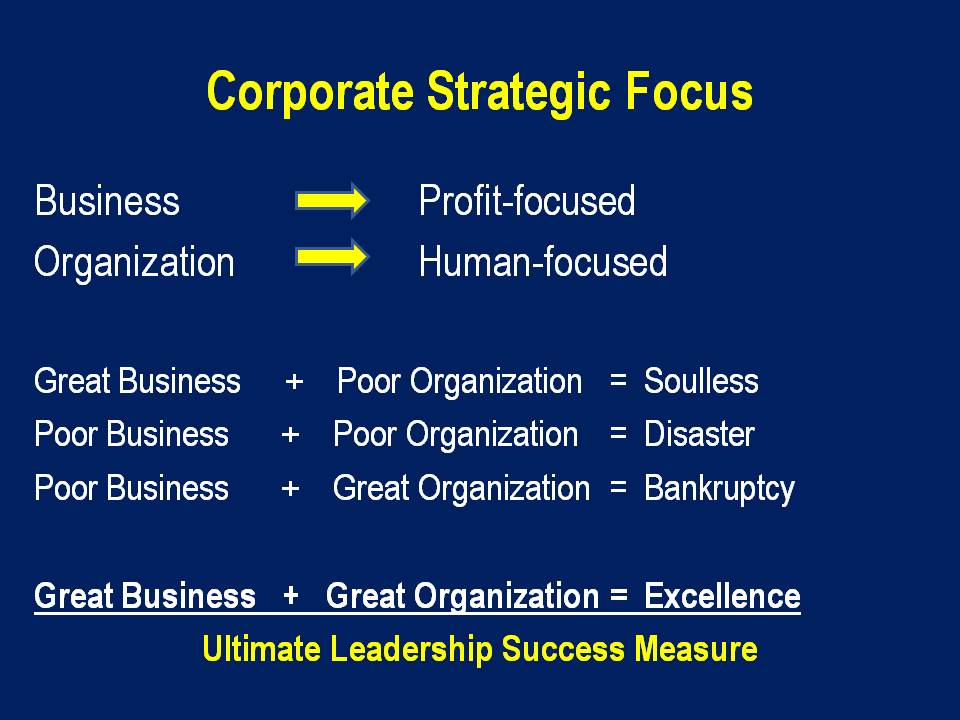
This includes, the developers behind the maintenance and upkeep of the technology, customer service professionals addressing the concerns of fickle customers, distribution personnel ensuring the safe and secure product/service delivery in a timely manner, etc. Therefore, it is critically important for the eCommerce provider to ‘own’ as much of the ‘journey’ as possible that transpires between the initial contact by the customers and the actual service/product deliveries to them. A critical part of such an equation is to value the treasure trove of inherent talent by taking care of their needs and expectations through the ‘prudently proactive’, rather than, ‘rationally reactive’ institutionalization of enlightened policies/processes/procedures. Following questions can be used as a guide in the respective context:
> Are they satisfied with the work environment?
> Do they feel empowered?
> Are they motivated to go above and beyond the call of duty?
> Does their voice count?
> Are their mistakes tolerated?
> Is their wellbeing given significance?
> Are they judiciously recognized and rewarded?
> Is the full spectrum of their capabilities known?
> Are they given an opportunity to display the widest bandwidth of their apparent and hidden skills?
> Is their training, learning, development, growth, and progression done in a timely, effective and fair manner?
The aforementioned questions can also provide the basis for increasing employee engagement, targeted training and development, formulating succession planning, and boosting retention of desired talent.
Keep a Keen Eye on Your Current / Potential Competitors
This refers to having an effective means of business intelligence that can foresee/forewarn of the disruptive capabilities/technologies/knowhow being leveraged/developed by current/potential competitors with profound implications for relevance and competitiveness within the relevant industry. Some questions that can be used as a guide in the respective context are:
> Are you the best in the industry?
> Do you benchmark often?
> Are there any known rising stars within the prevalent competitive landscape?
> Is there any technology that can disrupt the current ecosystem?
> Do you need to significantly improve / radically change (transform) the current business practices?
> Can you transform within the available resources?
Are you willing to pay the price for transformation, e.g., losing/retraining depreciating talent, restructuring the organization, reengineering business processes, upgrading the current infrastructure, investment in suitable technology, building a robust line of capable successors, changing current leadership, etc.
The following methodology can be used to supplement the aforementioned questions:
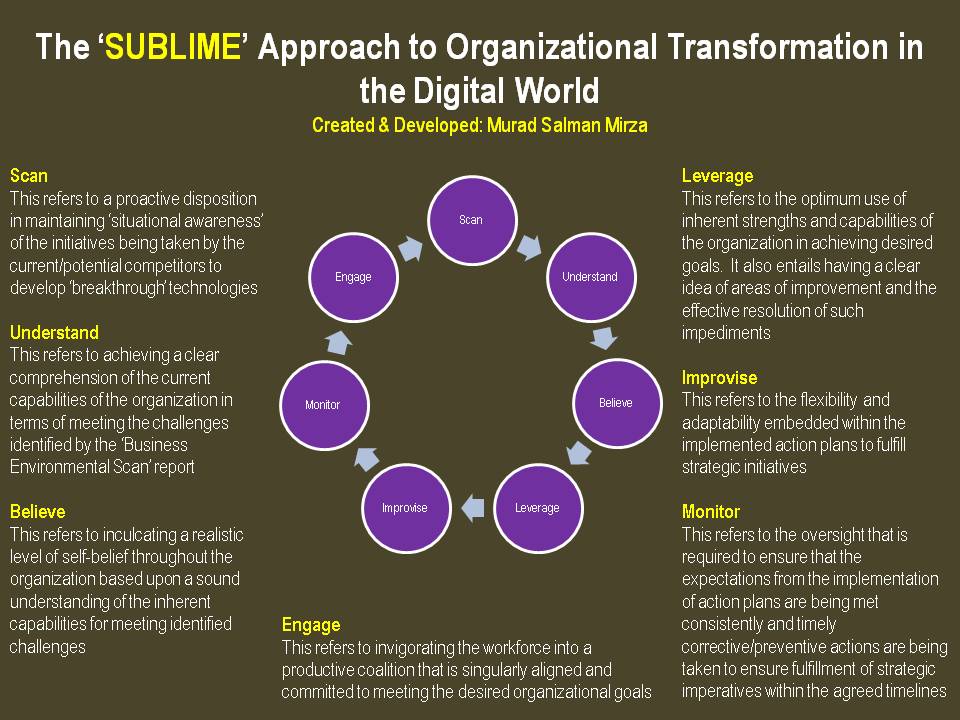
Such vigilance needs to be carried out periodically to avoid becoming antiquated as a consequence of floating in the serene calmness of complacency emanating from the assuring sense of past achievements.
Always Open the Door to Innovation, Especially, from Unexpected Sources
This refers to the magnanimity displayed by the organizational leadership to new ideas/insights/perspectives/approaches/methodologies that can emanate from all levels of the corporate hierarchy. Such an approach requires the courage to be delighted/surprised by the fruitful feedback from the conventionally marginalized/undiscovered/hidden parts of the ‘organizational brainpower’ in taking strategic/operational decisions. For example, having an online innovation forum/WhatsApp group administered by an impartial member of the senior management that is accessible to the frontline employees for suggesting innovative ways for improving service processes without fear of reprisal or favor to sycophants, and gaining due rewards and recognition for successful initiatives. Following are some of the questions that can be utilized as a guide in establishing and refining such practices:
> Do you hunger for, and are inclusive of, new ideas/practices/perspectives, especially, from unexpected sources?
> Do you encourage and enable employees at all levels of the organizational hierarchy to share their views on improving current practices?
> Can you see significant positive gains in important corporate metrics year-on-year based upon the direct/indirect inputs from the workforce?
> Is there a centralized online knowledge bank, especially, on ‘lessons learnt’ and ‘best practices’ that is easily accessible to the relevant workforce for improving their performance levels?
> Are ‘progressive learning’ and ‘knowledge sharing’ elevated to the stature of shared values within your organization?
The aforementioned questions can be reinforced by the realization gained from the following equations:
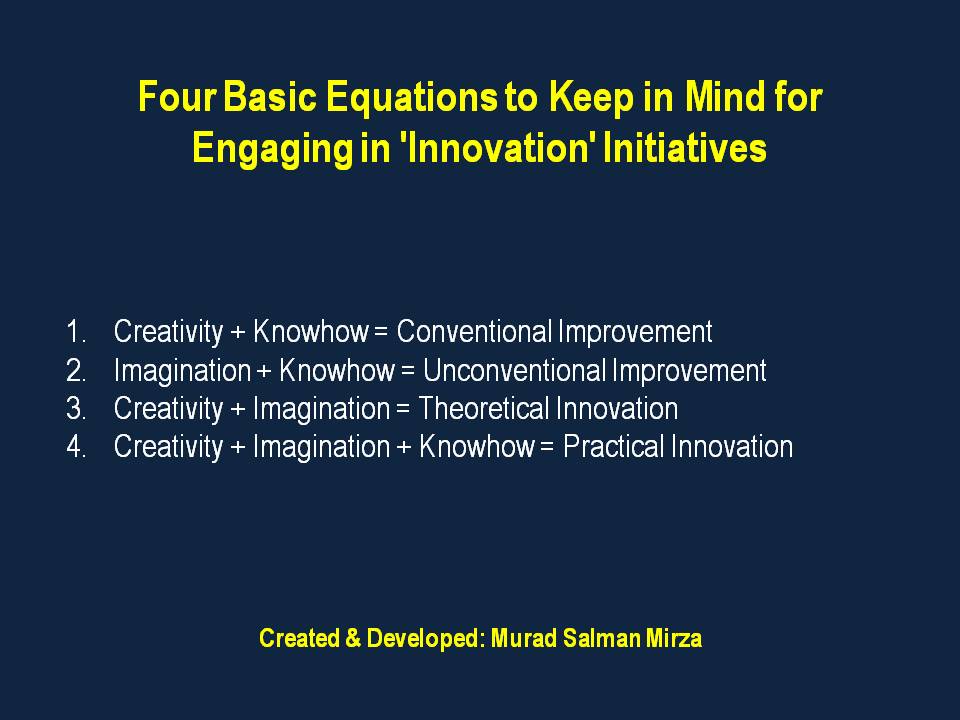
It is important to keep in mind that achieving a competitive edge in innovation is directly related to consistently winning the hearts and minds of the capricious customers that are increasingly unforgiving/impatient to service failings and prone to embracing competitors without the ‘nostalgia’ of loyalty, who can raise the bar for delightful experiences. For example:
> Integrating service/product offerings with Alexa, Siri, Google Assistant, Cortana, etc., for busy professionals who want to avoid conventional browsing through websites
> Leveraging VR/AR/IoT/Holographic technology for an enhanced shopping experience
> Creating environmentally-conscious services like the reintroduction of the ‘milkman model’ in a digital context
(https://www.greenbiz.com/article/loops-launch-brings-reusable-packaging-worlds-biggest-brands)
Food for Thought
eCommerce customers prefer to invest in relationships, rather than, just buying products/services. Such behavior has evolved from the familiarity of the ‘neighborhood shop’ that engendered feelings of belonging to, and being raised around, a certain level of ‘known’ humanistic interaction. Consciously or unconsciously they look for confidence boosters that can come closer to that sense of comfort associated with the knowledge that there is much more being exchanged than monetary value for services/products. Are you worthy of such trust as a conscientious eCommerce provider?






